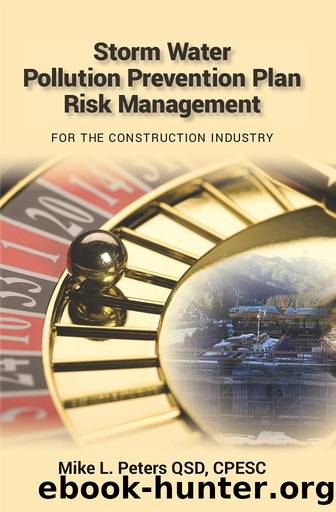Storm Water Pollution Prevention Plan Risk Management: For the Construction Industry (1st) by Peters Mike

Author:Peters, Mike [Peters, Mike]
Language: eng
Format: epub
Publisher: Independent Assurance Enterprises
Published: 2015-05-18T16:00:00+00:00
CHAPTER 11
Waste Management Best Management Practices (10)
W aste management consists of implementing procedural and structural BMPs for handling, storing, and disposing of construction materials and wastes generated by the project to prevent the release from the site of construction or waste materials via airborne or storm water discharges.
WM-1 Material Delivery and Storage —All material delivery and storage (WM-1) areas must be noted in the water pollution control drawings. Update the water pollution control drawings as often as new changes are made or removed and at least monthly by default. The WM-1s must have perimeter sediment control BMPs (usually fiber rolls or silt fence) and, if necessary, environmentally sensitive area fencing to delineate inactive project areas from project active construction areas. The storage site must also be protected from run-on water, if applicable, from any area up gradient of the site. The WM-1 area is usually considered an active or disturbed soil area unless entirely on asphalt, concrete, or other impervious surface. Many WM-1s have TC-2 or TC-1 stabilized construction roadway or temporary construction entry/exit BMPs installed. There should be no material or sediment tracking from the WM-1 area.
In most project special provisions, when hazardous materials are delivered and consequently stored at a project delivery site, the material delivery itself must be inspected, and the site storage area should be inspected daily while hazardous materials are present. The person receiving the hazardous materials should be trained in hazardous material handling and spill prevention and control .
Many WM-1 storage areas are a target-rich environment for deficiencies due to the multifaceted nature of the materials stored there. There is often hazardous waste, solid waste, fuel and fluids for equipment, and hazardous construction fluids and chemicals present, as well as construction vehicles and equipment. Oftentimes there are stockpiles at the WM-1 areas. All stockpile areas are also to be noted on the water pollution control drawings, even if the stockpiles are within the boundary of the WM-1. Stockpiles must be protected per WM-3 Stockpile Management storm water management plan (SWMP) specifications, which will be reviewed shortly under WM-3.
Hazardous waste and non-waste fluids must be stored in watertight secondary containment. A conex storage container with a wooden floor is not a secondary containment apparatus. If a five-gallon bucket of oil or paint spills near the door of the storage trailer, the fluid will escape into the soil or whatever surface the storage container is on, or the spilled fluid will be tracked by foot traffic outside the storage area. In short, the fluids are not contained. Many times I have seen the flooring of these storage containers rotten or broken, allowing construction fluids to leak out of the container into the soil. Oftentimes the roofs leak and allow storm water to enter the storage area. This can allow saturation of the wood flooring, leading to eventual failure of the structural integrity of the floor, and create opportunity for fugitive materials to enter the soil under the storage area. I have seen oil saturation of wooden floors to where the oil actually penetrates the wood and drips into the soil under the storage area.
Download
This site does not store any files on its server. We only index and link to content provided by other sites. Please contact the content providers to delete copyright contents if any and email us, we'll remove relevant links or contents immediately.
International Integration of the Brazilian Economy by Elias C. Grivoyannis(74175)
The Radium Girls by Kate Moore(11605)
Turbulence by E. J. Noyes(7690)
Nudge - Improving Decisions about Health, Wealth, and Happiness by Thaler Sunstein(7237)
The Black Swan by Nassim Nicholas Taleb(6754)
Rich Dad Poor Dad by Robert T. Kiyosaki(6170)
Pioneering Portfolio Management by David F. Swensen(6068)
Man-made Catastrophes and Risk Information Concealment by Dmitry Chernov & Didier Sornette(5640)
Zero to One by Peter Thiel(5484)
Secrecy World by Jake Bernstein(4384)
Millionaire: The Philanderer, Gambler, and Duelist Who Invented Modern Finance by Janet Gleeson(4087)
The Age of Surveillance Capitalism by Shoshana Zuboff(3979)
Skin in the Game by Nassim Nicholas Taleb(3964)
The Money Culture by Michael Lewis(3836)
Bullshit Jobs by David Graeber(3822)
Skin in the Game: Hidden Asymmetries in Daily Life by Nassim Nicholas Taleb(3718)
The Dhandho Investor by Mohnish Pabrai(3559)
The Wisdom of Finance by Mihir Desai(3520)
Blockchain Basics by Daniel Drescher(3324)
